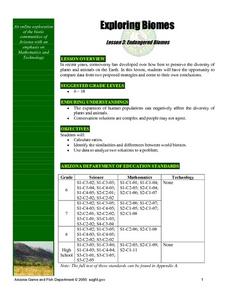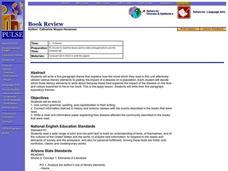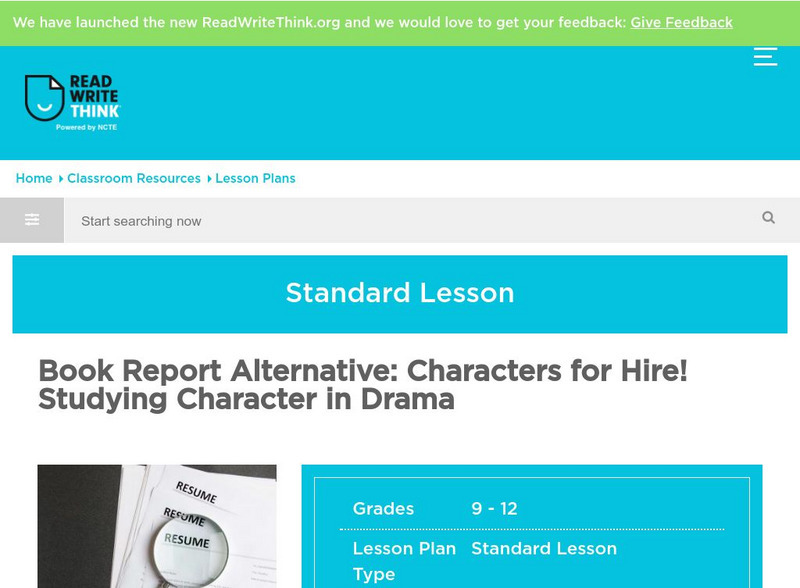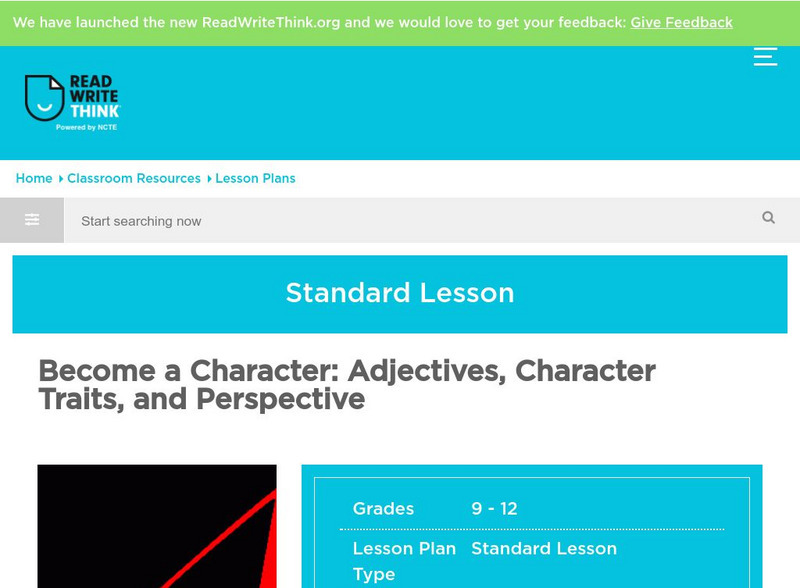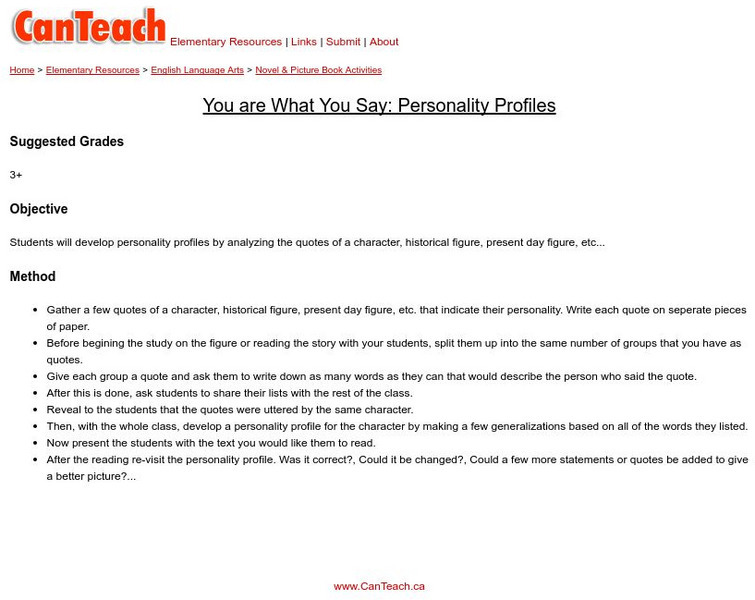Curated OER
AM to FM - Lesson 4
Students examine different music styles played on AM radio versus FM radio. They compare a 1972 music hit from AM radio with a 1972 hit album on FM radio.
Curated OER
Endangered Biomes
Students compare data from two proposed strategies on how ot best preserve the diversity of plants and animals. They complete a worksheet and share theirviews with the rest of the class.
Curated OER
Japanese Noh Masks
Students examine Japanese theatre and create their own face masks which display certain emotions, props, costumes and perform in improvisational theatrical games.
Curated OER
If We Knew Then What We Know Now -- Cuban Missile Crisis (Background)
Students examine the background of the Cuban Missile Crisis. Using the foreign policy decision-making process, they simulate and elaborate the processe involved. They identify the causes of the misconceptions that plagued the U.S.-Cuba...
Curated OER
Book Review
Learners write a five paragraph theme that explains how the novel which they read in this unit effectively utilized various literary elements to portray the impact of a disease on a population. They then decide which three literary...
Curated OER
Wh0-o-o-o's Out There?
Fifth graders describe the physical features of an owl and identify survival adaptations. They Investigate an owl's niche in an ecosystem. The students participate in an interactive puzzle on the internet that helps for motivation.
Curated OER
Physical Pendulum Lab
Students calculate the moment of inertia of a disc. In this physics lesson plan, students differentiate the two methods used in finding the inertia. They construct their own pendulum for the lab.
Curated OER
Anger (Part 1): Identifying Our Style
Students identify the two common sources of anger. For this psychology lesson, students discuss productive ways to express anger. They complete a reflection worksheet at the end of the lesson.
Lumen Learning
Lumen: Reading and Interpreting Literary Texts: How to Analyze a Short Story
This lesson focuses on analyzing a short story including all of the elements of a short story such as setting, plot and structure, and characterization.
Alabama Learning Exchange
Alex: Analyzing Characters in 12 Angry Men
Re-telling a story from the points of view of its various characters is a powerful way to review the events of a story, show how authors use characterization to reveal characters' personalities, and encourage students to view stories...
ReadWriteThink
Read Write Think: Studying Character in Drama
Online lesson that allows students to study and follow a Shakespearean character throughout a play, analyzing their actions, traits and dialogue as clues to characterization.
Utah Education Network
Uen: 2nd Grade Act. 12: Guess My Character
This lesson engages students in reading comprehension strategies related to Patricia Polacco's book, My Rotten, Red-Headed, Older Brother. Students will analyze the story's characters and create thought bubbles associated with each...
CPALMS
Cpalms: Five Little Monkeys: Comparing and Contrasting
[Free Registration/Login Required] Five little monkeys sitting on a bed or sitting in a tree? In this close reading lesson, students will compare and contrast the actions of the characters in two of Eileen Christelow's beloved books,...
ReadWriteThink
Read Write Think: Become a Character
In this online lesson plan and activity, young scholars actually "become" a character from a novel in their analysis of characterization. The lesson plan uses the Scarlet Letter, but any novel can be used. RL.9-10.3 Analyzing Characters,...
Florida Center for Reading Research
Florida Center for Reading Research: Character Consideration
A lesson plan in which students read a narrative text and complete graphic organizers to analyze a character. Materials are included. [PDF]
Florida Center for Reading Research
Florida Center for Reading Research: Character Characteristics
A lesson plan in which students read a narrative text and complete graphic organizers to analyze a character. Materials are included. [PDF]
Huntington Library
Huntington Library: Shakespeare's Universalism [Pdf]
In this lesson, students explore how Shakespeare was able to write in a way that his characters seemed to express real emotions and will look at the literary devices he used. An extension activity has them analyze what William Hazlitt...
PBS
Pbs Learning Media: Supernatural Elements in Macbeth
In this self-paced lesson, students explore how Shakespeare uses supernatural elements in Macbeth. It begins with an exploration of beliefs about the supernatural and witchcraft in Shakespeare's time as presented in a segment from...
Other
Steilacoom Historical School District No. 1: Dramatic Justice [Pdf]
For this lesson unit, students investigate how justice is perceived and addressed in different cultures and times by examining literature from around the world. Texts examined include: The Tragedy of Romeo and Juliet, A Sport of Nature...
ReadWriteThink
Read Write Think: Creating Careers for Characters
Interactive lesson which allows students to actually "become" a character in a story they have read. Students analyze and evaluate their character, and extend the activity into choosing a career for that character.
PBS
Pbs: American Masters: Lesson 2: Truman Capote: Other Voices, Other Rooms
This lesson plan is based on the PBS episode of American Masters about Truman Capote. Young scholars will read and analyze how Truman Capote develops characters as they record their findings on worksheets included with this lesson. Then...
Alabama Learning Exchange
Alex: Examining Character Motivation
During this unit, students will ask "Why do we do what we do?" They will read different novels to analyze character motivation. Throughout the unit they will debate whether they think characters made smart choices and why. They will also...
Can Teach
Can Teach: You Are What You Say Personality Profiles
In this lesson plan students will develop personality profiles by analyzing the quotes of a character, historical figure, present day figure, etc. Lesson plan indicated for 3rd grade and above.



